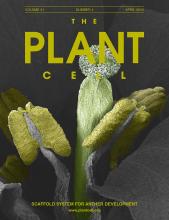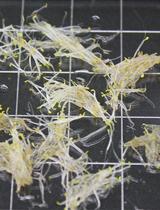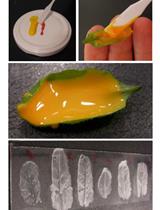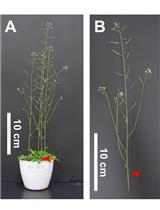- EN - English
- CN - 中文
Analysis of Monosaccharides from Arabidopsis Seed Mucilage and Whole Seeds Using HPAEC-PAD
利用HPAEC-PAD进行拟南芥种子黏液和整粒种子中单糖的测定
发布: 2019年12月20日第9卷第24期 DOI: 10.21769/BioProtoc.3464 浏览次数: 5440
评审: Yufang LuAgnieszka ZienkiewiczAnonymous reviewer(s)
Abstract
Arabidopsis seed coat epidermal cells deposit a significant quantity of mucilage, composed of the cell wall components pectin, hemicellulose, and cellulose, into the apoplast during development. When mature seeds are hydrated, mucilage extrudes to form a gelatinous capsule around the seed. Determining the monosaccharide composition of both extruded mucilage and whole seeds is an essential technique for characterizing seed coat developmental processes and mutants with altered mucilage composition. This protocol covers growth of plants to produce seeds suitable for analysis, extraction of extruded mucilage using water and sodium carbonate (used for mutants with impaired mucilage release), and extraction of alcohol insoluble residue (AIR) from whole seeds. The prepared polysaccharides are then hydrolyzed using sulfuric acid, which hydrolyses all polysaccharides including cellulose. Sensitive and reproducible quantification of the resulting monosaccharides is achieved using high-performance anion exchange chromatography coupled with pulsed amperometric detection (HPAEC-PAD).
Keywords: Arabidopsis (拟南芥)Background
In Arabidopsis, fertilization of the ovule initiates growth and differentiation of the ovule integuments into the seed coat (Beeckman et al., 2000; Western et al., 2000; Windsor et al., 2000). During differentiation, the outermost layer of integument cells begins to secrete large quantities of pectinaceous mucilage into the apoplastic space. This secretion is targeted to the point where the outer primary cell wall meets the radial cell wall, and leads to the formation of a donut-shaped pocket of mucilage surrounding a column of cytoplasm. After mucilage secretion is complete, the cytoplasmic column is replaced by a cellulosic secondary cell wall called the columella and the cells undergo programmed cell death prior to seed desiccation. When mature Arabidopsis seeds are hydrated, the mucilage expands and ruptures the primary cell wall. The extruded mucilage forms two distinct layers, a non-adherent layer that is easily detached, and an adherent layer that is strongly attached to the seed surface (reviewed in Šola et al., 2019a). Mucilage polysaccharides include pectin, hemicellulose, and cellulose. Ninety percent of the mucilage is pectin, of which 90% is unbranched Rhamnogalacturonan I (RG-I; reviewed in Voiniciuc et al., 2015).
The synthesis of seed coat mucilage is not necessary for plant viability under laboratory conditions (Western et al., 2001). In addition, seed mucilage is readily accessible in large quantities. This has allowed isolation of viable mutants and development of transgenic lines with altered seed coat mucilage. The analysis of these mutants and transgenic lines can be used to understand the biosynthesis, deposition, regulation and function of mucilage polysaccharides and serves as a model system for studying various aspects of cell wall biology (Arsovski et al., 2010; Haughn and Western, 2012; Western, 2012; North et al., 2014; Francoz et al., 2015; Voiniciuc et al., 2015; Griffiths and North, 2017; Francoz et al., 2018; Golz et al., 2018; Šola et al., 2019a).
An essential technique for analyzing mucilage is rapid, reliable, and simple quantification of monosaccharides. We have developed an HPAEC-PAD technique that has been employed successfully for over a decade (Dean et al., 2007; Huang et al., 2011; Mendu et al., 2011; Voiniciuc et al., 2013; Griffiths et al., 2014; Shi et al., 2019; Šola et al., 2019b). Our protocol for seed coat mucilage extraction includes modifications for mutants such as mucilage modified2 (mum2) that produce mucilage with altered properties that impair hydration and extrusion (Dean et al., 2007; Macquet et al., 2007). We also established a method for preparation of whole seed alcohol insoluble residue (AIR). As previous analysis in our lab has shown that much of the rhamnose (Rha) and galacturonic acid (GalA) in whole seed is derived from mucilage RG-I (Western et al., 2001), this analysis can be used to determine whether the total amount of mucilage synthesized is altered. The release of monosaccharides from mucilage polysaccharides and whole seed AIR is based on the secondary acid hydrolysis derived from the Klason procedure (Coleman et al., 2009). This protocol uses sulfuric acid instead of the trifluoracetic acid (TFA) used by other mucilage analysis protocols (e.g., Voiniciuc and Günl, 2016) to improve digestion of the cellulose in seed coat mucilage. Analysis of the resulting monosaccharides by HPAEC-PAD permits sensitive and reproducible detection of both neutral and acidic sugars. This protocol could also be adapted for use in other mucilage-producing species, including Plantago and flax (Western, 2012; Yang et al., 2012; Phan and Burton, 2018).
Materials and Reagents
- 35 mm Petri dishes (Thermo Fisher Scientific, catalog number: FB0875712)
- Serological pipettes, 50 ml
- 1 L autoclavable bottles for making and storing medium
- Plastic wrap
- Micropore tape (3M, catalog number: 1530-0)
- Plant pots, 12 cm
- Forceps
- Bamboo barbeque skewers, 30 cm
- Aluminum foil
- Small sieve OR WhatmanTM 3MM Chr Chromatography Paper (GE Healthcare, catalog number: 3030917) for removing chaff from seeds
- 2 ml boil-proof microcentrifuge tubes (VWR International, catalog number: 76332-080)
- 1.5 ml microcentrifuge tubes (VWR International, catalog number: 87003-294)
- 15 ml sterile polypropylene conical centrifuge tubes (e.g., Corning Life Sciences, catalog number: 431470)
- 50 ml sterile polypropylene conical centrifuge tubes (e.g., Corning Life Sciences, catalog number: 431472)
- Plastic rack for 1.5 ml and 2 ml tubes
- Plastic Pasteur pipettes, 5.8 ml (VWR International, catalog number: 612-4494)
- Plastic box to contain tubes on orbital shaker
- Tips for micropipettes
- Chemical resistant gloves (e.g., VWR International nitrile examination gloves, catalog number: 82026-426)
- Glass microscope slides with cavity (e.g., Ted Pella, catalog number: 260241)
- Face shield
- Safety glasses
- Ice bucket
- Bubble wrap
- Small box for vortexing samples (A tip box lid is ideal)
- 12 ml 16 x 100 mm KIMAX tubes with PTFE-faced rubber lined caps (VWR International, catalog number: SCERSP45066A-16100)
- Test tube brush for KIMAX tubes
- Porcelain pestles and mortars, 50 ml capacity (e.g., Coorstek, catalog number: 60310)
- 2 mm and 1 mm zirconia (zirconium dioxide) beads
- 2 ml screw-capped tubes (e.g., Precellys 2 ml Empty Reinforced Tubes with O-ring, catalog number: 9000538)
- UV syringe filters, 4 mm diameter, nylon, 0.45 μm pore size (Chromatographic Specialties, catalog number: CSUV04N451)
- 1 ml BD tuberculin syringes (VWR International, catalog number: 309659)
- Kimwipes (Kimtech, catalog number: 34120)
- 200 μl screw top microvials (Chromatographic Specialties, catalog number: C581311)
- Open top caps for HPLC vials (Chromatographic Specialties, catalog number: C223711M)
- 8 mm, 0.060” natural PTFE/silicone septa (Chromatographic Specialties, catalog number: C243M)
- Dry ice
- Ruthenium red, for microscopy (Sigma-Aldrich, catalog number: 00541)
- Sodium carbonate, anhydrous (Thermo Fisher Scientific, catalog number: S263)
- Sodium bicarbonate (Baking soda)
- meso-Erythritol (Sigma-Aldrich, catalog number: E7500)
- L-(-)-Fucose (Sigma-Aldrich, catalog number: F2252)
- L-(+)-Arabinose (Sigma-Aldrich, catalog number: A3256)
- L-Rhamnose (Sigma-Aldrich, catalog number: R3875)
- D-(+)-Galactose (Sigma-Aldrich, catalog number: G6404)
- D-(+)-Glucose (Sigma-Aldrich, catalog number: G8270)
- D-(+)-Mannose (Sigma-Aldrich, catalog number: M2069)
- D-(+)-Xylose (Sigma-Aldrich, catalog number: X3877)
- D-(+)-Galacturonic Acid (Sigma-Aldrich, catalog number: 48280)
- Sulfuric Acid, Certified ACS Plus (Thermo Fisher Scientific, catalog number: A300-212)
- 95% ethanol
- 70% ethanol (v/v) in ultrapure water
- HPLC-grade methanol (Sigma-Aldrich, catalog number: 34885)
- 80% HPLC-grade methanol (v/v) in ultrapure water
- HPLC-grade acetone (Sigma-Aldrich, catalog number: 439126)
- Sodium hydroxide solution (50% w/w Certified NaOH, Thermo Fisher Scientific, catalog number: SS254-4)
- Anhydrous sodium acetate (CH3COONa, Thermo Fisher Scientific, catalog number: S210-500)
- Ultrapure water (18.2 MΩ cm at 25 °C)
- Agar (Thermo Fisher Scientific, catalog number: BP1423)
- 1 M KOH for adjusting pH of medium
- Sunshine Mix #5 (Sungro) or growth medium of your choice (see Notes)
- AT minimal medium, with or without agar (see Recipes)
- 20 mM sodium carbonate solutions (see Recipes)
- Ruthenium red solution (see Recipes)
- 100 mM monosaccharide stock solution (see Recipes), stored at -20 °C
- 72% (w/w) sulfuric acid (see Recipes)
- Dilution series for monosaccharide standards (see Recipes)
- meso-Erythritol solution, 5 mg/ml (see Recipes), stored at -20 °C
- 1 M NaOH (HPAEC-PAD eluent) (see Recipes)
- 200 mM NaOH (HPAEC-PAD eluent) (see Recipes)
- 1 M sodium acetate (HPAEC-PAD eluent) (see Recipes)
Equipment
- Micropipettes for volumes ranging from 5 μl to 1 ml
- 5 ml, 10 ml, 100 ml, 1.5 L and 2 L volumetric flasks
- 100 ml beakers
- 3 x 2 L vacuum side arm flasks with stoppers and vacuum tubing for degassing HPAEC eluents
- pH meter
- Magnetic stirrer and stir bars
- Autoclave
- Growth chamber with light level and temperature controls (for plates, and growth of plants to maturity)
- Analytical balance
- Microcentrifuge
- Lab balance
- Vortex mixer with 3-inch platform (Scientific Industries, Vortex-Genie 2, catalog number: SI-0236)
- Orbital shaker (New Brunswick Scientific, Innova 2000 platform shaker)
- Dissecting or compound microscope with camera (e.g., Zeiss Axioscop2 with Leica DFC450C and Leica application suite 4.2)
- Fume hood
- Reacti-Vap evaporator (Thermo Fisher Scientific, catalog number: TS-18825) with Reacti-Therm heating module (Thermo Fisher Scientific, catalog number: TS-18822)
- Nitrogen (N2) gas (Praxair, NI M-T), connected to Reacti-Vap
- Ice machine
- Access to vacuum line (e.g., integral building vacuum) for degassing HPAEC-PAD solutions
- Ion chromatography (IC): Dionex DX600 system equipped as follows:
- AS50 autosampler
- GP50 gradient pump
- ED50 electrochemical detector
- CarboPac PA1 standard bore guard (4 x 50 mm) (Thermo Fisher Scientific, catalog number: 043096)
- CarboPac PA1 analytical column (4 x 250 mm) (Thermo Fisher Scientific, catalog number: 035391)
Software
- Chromeleon 6.8 chromatography data system software (Thermo Fisher Scientific, Dionex)
- Python 2.7 (https://www.python.org/download/releases/2.7/)
- Scientific Python (SciPy) package (https://www.scipy.org/install.html)
- Notepad ++ (Don Ho, https://notepad-plus-plus.org/)
- Microsoft Excel (Microsoft)
Procedure
文章信息
版权信息
© 2019 The Authors; exclusive licensee Bio-protocol LLC.
如何引用
Dean, G. H., Sola, K., Unda, F., Mansfield, S. D. and Haughn, G. W. (2019). Analysis of Monosaccharides from Arabidopsis Seed Mucilage and Whole Seeds Using HPAEC-PAD. Bio-protocol 9(24): e3464. DOI: 10.21769/BioProtoc.3464.
分类
植物科学 > 植物细胞生物学 > 细胞壁
植物科学 > 植物生理学 > 组织分析 > 细胞壁
生物化学 > 糖类
您对这篇实验方法有问题吗?
在此处发布您的问题,我们将邀请本文作者来回答。同时,我们会将您的问题发布到Bio-protocol Exchange,以便寻求社区成员的帮助。
提问指南
+ 问题描述
写下详细的问题描述,包括所有有助于他人回答您问题的信息(例如实验过程、条件和相关图像等)。
Share
Bluesky
X
Copy link












